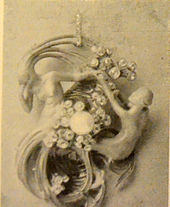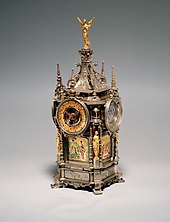Henri Vever

Henri Vever (1854–1942) was one of the most preeminent European jewelers of the early 20th century, operating the family business, Maison Vever, started by his grandfather.
By the early 20th century, Vever had amassed a collection of many thousands of fine ukiyo-e prints. His collection was so well regarded that the authors of some of the pioneering European scholarly works on ukiyo-e used Vever's collection for much their research on actual prints. Such authors include von Seidlitz, Migeon, and Lemoisne, whose L'Estampe Japonaise used Vever's prints exclusively.[2]
At the peak of

Although the thousands of pieces that made their way back to Japan via Matsukata included many of the masterpieces of the ukiyo-e movement, Vever had kept many of his best prints for himself and continued to collect after the First World War, acquiring pieces from former rivals Gonse, Haviland, Manzi, Isaac, and Javal as their collections went to the auction houses of Paris. The sale took place in four parts, each in London:
- Part I: 26 March 1974, 412 lots[6]
- Part II: 26 March 1975, 410 lots[7]
- Part III: 24 March 1977, 415 lots[8]
- Final Part: 30 October 1997, 197 lots[9]
Works from the first two parts were soon re-printed, together with 148 prints not sold at those auctions, in a limited-edition (2000-copy) three-volume catalog: Japanese Prints & Drawings from the Vever Collection, by Jack Hillier.[2]
Vever's grandson, François Mautin, competed at the 1928 Winter Olympics in the ice hockey tournament.[10]
References
- ^ a b "Henri Vever A Finding Aid to His Papers". Freer Gallery of Art and Arthur M. Sackler Gallery Archives. Archived from the original on 5 August 2013. Retrieved 4 August 2013.
- ^ ISBN 0-85667-025-1.)
{{cite book}}: CS1 maint: location (link - ^ Michener, James A. (1954). The Floating World. New York, New York: Random House, Inc. pp. 244–5.
- ^ Meech, Julia (1988). The Matsukata Collection of Ukiyo-e Prints: Masterpieces from the Tokyo National Museum. New Jersey: Zimmerli Art Museum, Rutgers University. pp. 18–23.
- ^ Melikian, Souren (2002-08-31). "PARIS AUCTIONS : Opening a time capsule of Japanese woodcuts". New York Times. Retrieved 4 August 2013.
- ^ Catalogue of Highly Important Japanese Prints, Illustrated Books and Drawings from the Henri Vever Collection. London, England: Sotheby & Co. 1973.
- ^ Catalogue of Highly Important Japanese Prints, Illustrated Books and Drawings from the Henri Vever Collection. London, England: Sotheby & Co. 1975.
- ^ Catalogue of Highly Important Japanese Prints, Illustrated Books and Drawings from the Henri Vever Collection. London, England: Sotheby & Co. 1977.
- ^ Catalogue of Highly Important Japanese Prints, Illustrated Books and Drawings from the Henri Vever Collection. London, England: Sotheby & Co. 1997.
- ^ "François Mautin Olympic Results". Sports Reference. Archived from the original on 17 April 2020. Retrieved 10 May 2019.
